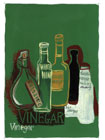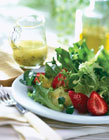
Salads and salad dressings have become so varied in their combinations, permutations and flavor subtleties it would be hard to a fashion any kind of personality profile based on salad preferences. However, there may be an element of psychology at work in the salad domain. For in this age of growing concern over obesity and healthy eating, the foodservice salad has come to embody the consumer's ongoing mental tug-of-war between the aspiration to eat “better” and the base desire to eat “well.”
While the angel on the consumer's right shoulder is having more sway, the devil on the left usually gets in his two cents. His whispered enticements to eat everything from fat- and calorie-laden dressings to fried chicken strips to heaping helpings of cheese often result in a food choice that is barely healthier than a burger and fries.
Indeed, today's multitude of salad offerings has come to symbolize the difficulty in wrestling with food choices. On the one hand is the desire to eat healthy and experiment with new foods. On the other, the equally strong pull of wanting something that not only tastes good but is filling and familiar.
The end result is that these two opposing desires are driving innovation and experimentation that has turned the salad into one of the more interesting and dynamic growth areas in foodservice.
“The whole 'premium' movement that's taking place in foodservice is being reflected in the salad category,” says Maria Caranfa, director of Mintel Menu Insights, a foodservice trends watcher. “We're seeing bigger, bolder flavors in dressings, the use of more fruit in salads and bolder flavors that reflect regional cuisines like Southwestern. Restaurateurs are being very thoughtful when it comes to flavors in salads, and while more salads are going gourmet, many are also trying to offer salads that are lighter and highlight the health and freshness aspect.”
In the spring of 2006, Mintel conducted a survey of 350 chain restaurants, 150 independent restaurants and 50 leading chef-owned finer dining establishments. The results revealed that a broad and bold spectrum of ingredients, flavors and combinations are appearing in salad and dressing offerings.
For instance, the survey found that more and increasingly different types of protein are finding their way into salads. As more consumers turn to salads as an entrée, protein becomes an essential salad component.
Chicken remains the leading salad protein, racking up 13% more occurrences in menued salads between the first quarter of 2005 and the second quarter of 2006. However, beef, salmon, shrimp and ahi tuna scored even bigger gains. Beef was noted 98 times in Q1 2005, but was cited 136 times in Q2 2006. Beef trailed behind chicken and turkey in mentions of meat proteins in salad. During the same sampling periods, shrimp—by far the top seafood protein in salads—advanced from 213 mentions to 253; salmon grew from 85 to 119; and ahi tuna climbed from 23 to 34.
Protein in the form of nuts also is showing up in more restaurant salads. Walnuts are the top addition, registering 118 mentions in Q1 2006 (all the other references were to Q2 of 2006), up from 89 in Q1 2005. Almonds, pecans, pine nuts, peanuts and cashews, most of which also showed at least modest increases, rounded out the top nut additions.
A growth in seafood salads was another notable development in the past year. “Ahi tuna replaced salmon at one point in the last year as a big ingredient, but that fell off and gave way once again to salmon,” says Caranfa.
While tried-and-true “salad with chicken,” unspecified “salad” and “garden salad” garnered the most mentions on menus, the top 25 list had its share of edgier concoctions. In addition to old standbys like “Asian salad” “Cobb salad” and “spinach salad,” the list included “fried chicken salad” “salad with steak,” “buffalo chicken salad” and “caprese salad.” The latter, Caranfa notes, is one of the hot new trends in restaurant salads, racking up 60 menu mentions.
“Usually a salad consisting of fresh tomatoes, mozzarella cheese and basil, along with a balsamic vinaigrette, the caprese salad is showing up more because it's perceived as simple, fresh and clean, and nothing in the dish is overpowering,” she says. “The caprese salad is an extension of the caprese pasta, chicken and pizzas that started that flavor profile trend. It started in the fine dining segment, but it's now expanding slowly to casual and fast casual.”
Mintel's research discovered that another emerging salad type is the “beet salad.” Though it showed up on just 24 menus, the salad is becoming a popular way to offer a long ignored, but intriguing vegetable.
“Kind of the like the caprese salad, it's still pretty much found only in fine dining because it's an ingredient that's not widely consumed,” Caranfa says. “The beet's color and heirloom varieties are helping drive the trend, along with their mild flavor and the trend toward incorporating roasted vegetables in salads. Most of the beet salads are using roasted forms of the vegetable, rather than standard pickled form.”

PHOTO COURTESY OF MCCORMICK SEASONINGS
Dressing as Salad Soul
For all the work being done on expanding the ingredient base in restaurant salads, the salad's soul still resides in the dressing. Mintel's research reveals that restaurateurs understand this and are willing to take risks when it comes to flavor combinations and types.While mainstays like Caesar, ranch, blue cheese, Italian and generic “salad dressing” accounted for the most menu mentions, flavor profiles within those categories are expanding. From cilantro Caesar, to chipotle pepper ranch and bleu cheese, to balsamic vinegar mustard, boring dressings are being dressed up.
However, the real action in dressings continues to be in the vinaigrette category. Exhibiting a huge range of flavor profiles, vinaigrettes are gaining popularity as a healthier alternative to creamy dressings that also help complement increasingly complex salad combinations.
“Lighter dressings are being offered more, and more menus have choices of new vinaigrettes,” Caranfa says.
Balsamic, red wine, Italian, raspberry, lemon, herb, basil and citrus were the most common vinaigrettes that Mintel found. However, sherry, ginger and tomato, cilantro, bleu cheese and apple cider turned up on menus as well.
Indeed, they are big sellers at Salad Creations, one of several chains of salad bistros that seek to satisfy consumer's salad cravings with made-to-order dishes prepared in an open kitchen. The chain's CEO, Jeff Levine, says vinaigrettes, many of which are highly customized, are by far the top choice.
“Heavier dressings still are big, but healthier vinaigrettes probably outsell the creamy dressings ten to one,” he says. “We're constantly working on new ones, such as a low-fat Chinese plum fruit-based dressing, cucumber-wasabi mustard and spicy Thai peanut. Our big sellers, though, continue to be 12-year-old balsamic, roasted garlic and Asian sesame-ginger [dressings].”
Dressings are also a big concern for the Saladworks restaurant chain. Joe Gianetti, the company's vice president of franchise services, says dressings are the key linchpin in salads because they unlock the salad's flavor when properly formulated and paired with other ingredients. In terms of healthfulness, he insists that it is the dressings that make or break a salad.
“Ranch, Caesar and Italian are still the big movers, but people are gravitating to vinaigrettes because they're perceived as less filling and fattening. We're trying to work on more interesting dressings, such as a pumpkin vinaigrette, which we pair with our newest seasonal salad, an autumn harvest salad that features turkey, onion, apple chips and the vinaigrette. Other ones include a chianti pesto dressing, a barbecue ranch for our crispy chicken salad and a cocktail balsamic vinaigrette that will mimic the flavor of a cocktail sauce for use in our shrimp salads.”

Pushing the Envelope
While dressings are getting a lot of attention at both chains, other elements are hardly being forgotten. Both executives say they are looking at everything from adding more premium proteins to experimenting with different greens bases to pushing the envelope with more exotic ingredients and more interesting combinations.“We'll be adding a fifth green to the four we now rely on —romaine, spring mix, Iceberg lettuce, spring mix and spinach,” Levine says. “We'll probably rotate the fifth one in, depending on what happens to be a good buy at the time. The dressings and lettuce side is where the innovation comes into play. Once they try some of the different types of lettuce that are available, I think people will see the different flavor and nutritional profiles they offer.”
Gianetti says Saladworks is also considering different greens, but is hesitant to go too far out on a limb with exotic ones like arugula, which might have limited appeal. One tactic the chain has developed to broaden the base of its salads is pairing greens with pastas like radiattore in a half-and-half combination.
Both companies are also focusing on adding higher quality protein. Gianetti says Saladworks has thought about increasing the size of the shrimp it includes in its Newport salad, which pairs tuna and shrimp. Additionally, it is also contemplating altering its chicken-based salads by replacing strips with a whole chicken breast. “We're looking to try to upgrade a bit,” he says.
At Salad Creations, Levine says salmon represented the first test of incorporating a more premium protein. Wild salmon proved to be a huge hit and has gone over well with the 80% to 85% of consumers who order some kind of protein with their salad.
The chain's success with trendy salmon is ample evidence that for all the novelty and experimentation that restaurateurs seek to incorporate in their salad offerings, salads must still reflect mainstream consumer tastes. While there is a lot happening on the fringes, the salad bowl still has to have a familiar ring to it.
“Salads have to taste good, and they have to offer ingredients that people understand,” Levine says. “Still, we think salads can be an everyday item.”
Website Resources:
www.keystone.org/Public_Policy/Obesity.html -- Link to USDA's sponsored May 2006 “Keystone Forum on Away-From-Home Foods: Opportunities for Preventing Weight Gain and Obesity” reportwww.PreparedFoods.com -- Type in terms such as “salad and foodservice” into the LINX search field